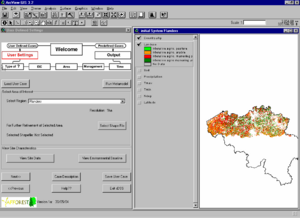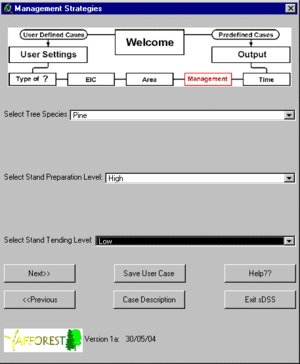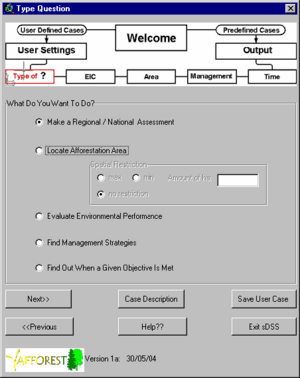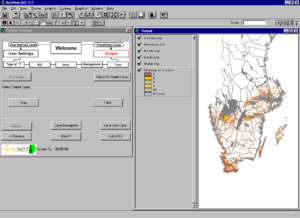Difference between revisions of "AFFOREST-sDSS"
m |
(finished?) |
||
| Line 8: | Line 8: | ||
AFFOREST-sDSS deals with environmental performance of afforestation on agricultural land in northwestern Europe. This environmental performance is measured according to three parameters: carbon sequestration, groundwater recharge, and nitrate leaching. | AFFOREST-sDSS deals with environmental performance of afforestation on agricultural land in northwestern Europe. This environmental performance is measured according to three parameters: carbon sequestration, groundwater recharge, and nitrate leaching. | ||
| + | [[Category:Finished articles]] | ||
[[Category:2004]] | [[Category:2004]] | ||
[[Category:Decision support system]] | [[Category:Decision support system]] | ||
[[Category:Supranational DSS]] | [[Category:Supranational DSS]] | ||
| + | [[Category:Belgian DSS]] | ||
| + | [[Category:Dutch DSS]] | ||
| + | [[Category:Danish DSS]] | ||
| + | [[Category:Swedish DSS]] | ||
[[Category:Spatial DSS]] | [[Category:Spatial DSS]] | ||
| + | [[Category:Pinus sylvestris]] | ||
| + | [[Category:Picea abies]] | ||
| + | [[Category:Quercus robur]] | ||
| + | [[Category:Fagus sylvatica]] | ||
| + | [[Category:Afforestation management]] | ||
[[Category:Carbon sequestration]] | [[Category:Carbon sequestration]] | ||
[[Category:Groundwater recharge]] | [[Category:Groundwater recharge]] | ||
[[Category:Nitrate leaching]] | [[Category:Nitrate leaching]] | ||
| + | [[Category:Tactical planning]] | ||
| + | [[Category:Strategic planning]] | ||
| + | [[Category:Goal programming]] | ||
[[Category:Stand level]] | [[Category:Stand level]] | ||
[[Category:Regional level]] | [[Category:Regional level]] | ||
| + | [[Category:Goal-driven DSS]] | ||
| + | [[Category:Government use]] | ||
| + | [[Category:Windows Client OS]] | ||
| + | [[Category:GIS application]] | ||
[[Category:Avenue]] | [[Category:Avenue]] | ||
| + | [[Category:Free of charge]] | ||
[[Image:Afforest.gif|thumb|400px|AFFOREST project logo]] | [[Image:Afforest.gif|thumb|400px|AFFOREST project logo]] | ||
| Line 25: | Line 43: | ||
This [[:Category:Decision support system|DSS]] arise from the EU-project AFFOREST<ref>[http://www.sl.kvl.dk/afforest/ AFFOREST project (EU 5th framework program for Research & Technological Development)]</ref>. This is not an any nation project, but a supranational project, developed in partnership by researchers from Flanders (Belgium), the Netherlands, Denmark and Sweden. | This [[:Category:Decision support system|DSS]] arise from the EU-project AFFOREST<ref>[http://www.sl.kvl.dk/afforest/ AFFOREST project (EU 5th framework program for Research & Technological Development)]</ref>. This is not an any nation project, but a supranational project, developed in partnership by researchers from Flanders (Belgium), the Netherlands, Denmark and Sweden. | ||
| − | AFFOREST-sDSS attends to evaluating the environmental impact of the afforestation process by comparing the environmental performance (EP) of the initial system, i.e. the agricultural land, with the EP of the same land after afforestation. There are considered 36 possible afforestation management practices; combinations of tree species choice, site preparation and thinning regime. | + | AFFOREST-sDSS attends to evaluating the environmental impact of the afforestation process by comparing the environmental performance (EP) of the initial system, i.e. the agricultural land, with the EP of the same land after afforestation. There are considered 36 possible afforestation management practices; combinations of tree species choice ([[:Category:Pinus sylvestris|pine]], [[:Category:Picea abies|spruce]], [[:Category:Quercus robur|oak]] and [[:Category:Fagus sylvatica|beech]] are allowed), site preparation and thinning regime. |
The environmental impact categories (EICs) under study are highly dependent on spatially variable site conditions, so this DSS was developed as a [[:Category:Spatial DSS|spatial DSS]]. | The environmental impact categories (EICs) under study are highly dependent on spatially variable site conditions, so this DSS was developed as a [[:Category:Spatial DSS|spatial DSS]]. | ||
| Line 31: | Line 49: | ||
=== System origin === | === System origin === | ||
* Universities and research centres belonging to the EU-project AFFOREST | * Universities and research centres belonging to the EU-project AFFOREST | ||
| − | * At the start of the AFFOREST project, potential users (spatial planners active in national and regional administrations, afforestation policy planners and managers of afforestation projects) from the participant lands (Sweden, Denmark, the Netherlands and Flanders) were consulted. | + | * At the start of the AFFOREST project, potential users (spatial planners active in national and regional administrations, afforestation policy planners and managers of afforestation projects) from the participant lands (Sweden, Denmark, the Netherlands and Flanders) were consulted. This showed as their principal requirements support to select sites and choose among alternative options for afforestation management and afforestation duration with a view to optimise the impacts or performance of afforestation. |
* It is free downloadable at the [http://www.sl.kvl.dk/afforest/ AFFOREST webpage] | * It is free downloadable at the [http://www.sl.kvl.dk/afforest/ AFFOREST webpage] | ||
| − | * <>does it have real-life application cases | + | * <span style="color:red">does it have real-life application cases</span> |
=== Support for specific issues === | === Support for specific issues === | ||
| Line 48: | Line 66: | ||
=== Capability to support decision making phases === | === Capability to support decision making phases === | ||
| − | + | * Intelligence: | |
| − | + | *: the system was developed taking into account the foreseen users opinion. | |
| − | + | * Design: | |
| − | * | + | *: users preferences are asked in order to answer their concerns. |
| − | * Design | + | * Choice: |
| − | * Choice | + | *: results enables the comparison between the possible future scenarios resulting from current afforestation decisions, then making easier the decision-making process. |
| − | * Monitor | + | * Monitor: |
| − | + | *: not implemented | |
| − | + | ||
| − | + | ||
== Data and data models == | == Data and data models == | ||
| + | [[Image:AFFOREST Graphical window.png|thumb|300px|AFFOREST-sDSS site viewing screenshot]] | ||
| + | [[Image:AFFOREST(ation) strategies.png|thumb|300px|AFFOREST-sDSS management alternatives choosing screenshot]] | ||
=== Typical spatial extent of application === | === Typical spatial extent of application === | ||
| Line 69: | Line 87: | ||
=== Forest data input === | === Forest data input === | ||
| − | Once the study area is defined, it is represented by an ArcView grid. Here, each pixel class of this grid is used as input. This input parameters are derived from soil and land use maps, and geo-referenced sets of data on precipitation and atmospheric deposition. | + | Once the study area is defined, it is represented by an ArcView grid. Here, the AFFOREST geographical database provides the basic information, each pixel class of this grid is used as input. This input parameters are derived from soil and land use maps, and geo-referenced sets of data on precipitation, temperature and atmospheric nitrogen deposition. |
=== Type of information input from user (via GUI) === | === Type of information input from user (via GUI) === | ||
| − | User can specify one of the fourteen type questions. These questions are the fourteen one-, two- or three-parameters combinations of four management specifications: initial system, | + | User can specify one of the fourteen type questions. These questions are the fourteen one-, two- or three-parameters combinations of four management specifications: where? (initial system characteristics), how much? (evolution of these characteristics after afforestation), how? (afforestation management), and how long? (time horizon). For each of these combinations asked, the remaining management specifications are required as input. Furthermore, the number of solutions depend on the size of the combination question, e.g. if only one parameter is asked, the three remaining are specified as input, and there would be only a possible solution for this sole parameter. |
However, questions can be easily transformed to simple queries to the spatial database if only one of the EICs is of interest or if EICs are addressed as constraints or boundaries. If not, question leads to a complex query which needs the use of mathematical algorithms. In this case, goal programming with interval techniques are used. | However, questions can be easily transformed to simple queries to the spatial database if only one of the EICs is of interest or if EICs are addressed as constraints or boundaries. If not, question leads to a complex query which needs the use of mathematical algorithms. In this case, goal programming with interval techniques are used. | ||
| Line 80: | Line 98: | ||
=== Forest models === | === Forest models === | ||
| − | AFFOREST-sDSS uses the | + | AFFOREST-sDSS uses the metamodel METAFORE to compute the environmental performance for each initial system in the study area with the data provided by the AFFOREST spatial database. |
== Decision Support == | == Decision Support == | ||
| + | [[Image:AFFOREST questions.png|thumb|300px|AFFOREST-sDSS screenshot when asking for goals]] | ||
=== Definition of management interventions === | === Definition of management interventions === | ||
| Line 89: | Line 108: | ||
=== Typical temporal scale of application === | === Typical temporal scale of application === | ||
| − | + | METAFORE model allows the performance of a yearly time step up to 100 years after afforestation. | |
=== Types of decisions supported === | === Types of decisions supported === | ||
| Line 96: | Line 115: | ||
**administrative decisions | **administrative decisions | ||
**operating control decisions | **operating control decisions | ||
| − | |||
* planning decisions | * planning decisions | ||
**organizing decisions | **organizing decisions | ||
| − | |||
**control decisions | **control decisions | ||
| − | ** coordination decisions | + | **coordination decisions |
*decision making situation | *decision making situation | ||
**unilateral | **unilateral | ||
| − | ** collegial | + | **collegial |
**Bargaining / participative decision making | **Bargaining / participative decision making | ||
| Line 112: | Line 129: | ||
== Output == | == Output == | ||
| + | [[Image:AFFOREST output settings.png|thumb|300px|AFFOREST-sDSS graphical output for a case study]] | ||
=== Types of outputs === | === Types of outputs === | ||
| Line 117: | Line 135: | ||
=== Spatial analysis capabilities === | === Spatial analysis capabilities === | ||
| − | + | Data input of graphically selected sites is queried to the AFFOREST spatial database. Non GUI input data apart from managements strategies and simulation goals are required. | |
| − | + | ||
| − | + | Also, AFFOREST-sDSS GIS capabilities are performed when showing results in map forms. | |
| − | + | ||
=== Abilities to address interdisciplinary, multi-scaled, and political issues === | === Abilities to address interdisciplinary, multi-scaled, and political issues === | ||
| Line 129: | Line 146: | ||
=== System requirements === | === System requirements === | ||
| − | * Operating Systems: | + | * Operating Systems: Microsoft® Windows® 98/ME, Windows NT 4.0, Windows 2000, Windows XP-Home Edition and Professional. |
| − | * Other software needed | + | * Other software needed: ArcView™ 3.2 |
| − | * Development status | + | * Development status: finished |
=== Architecture and major DSS components === | === Architecture and major DSS components === | ||
| Line 137: | Line 154: | ||
The system consists of three different modules (a metamodel, a spatial database and a decision module) and the graphical user interface (GUI). | The system consists of three different modules (a metamodel, a spatial database and a decision module) and the graphical user interface (GUI). | ||
| − | |||
=== Usage === | === Usage === | ||
The envisaged users of AFFOREST sDSS are afforestation policy planners in national and regional administrations and local managers of afforestation projects. | The envisaged users of AFFOREST sDSS are afforestation policy planners in national and regional administrations and local managers of afforestation projects. | ||
| − | |||
=== Computational limitations === | === Computational limitations === | ||
| − | + | AFFOREST-sDSS software and help downloadable package requires some free hard-drive space, taking more than 1 Gb when decompressed. | |
=== User interface === | === User interface === | ||
| Line 150: | Line 165: | ||
=== Documentation and support === | === Documentation and support === | ||
| − | + | A tutorial and more information can be found in the AFFOREST web-page. | |
=== Installation === | === Installation === | ||
| − | * | + | * Cost: free of charge, non-cost downloadable in the AFFOREST web-page. |
| − | + | ||
| − | + | ||
==References== | ==References== | ||
Revision as of 20:32, 21 September 2009
General System description
System name: AFFOREST spatial Decision Support System
Acronym: AFFOREST-sDSS
Brief overview
AFFOREST-sDSS deals with environmental performance of afforestation on agricultural land in northwestern Europe. This environmental performance is measured according to three parameters: carbon sequestration, groundwater recharge, and nitrate leaching.Contents
Scope of the system
This DSS arise from the EU-project AFFOREST[1]. This is not an any nation project, but a supranational project, developed in partnership by researchers from Flanders (Belgium), the Netherlands, Denmark and Sweden.
AFFOREST-sDSS attends to evaluating the environmental impact of the afforestation process by comparing the environmental performance (EP) of the initial system, i.e. the agricultural land, with the EP of the same land after afforestation. There are considered 36 possible afforestation management practices; combinations of tree species choice (pine, spruce, oak and beech are allowed), site preparation and thinning regime.
The environmental impact categories (EICs) under study are highly dependent on spatially variable site conditions, so this DSS was developed as a spatial DSS.
System origin
- Universities and research centres belonging to the EU-project AFFOREST
- At the start of the AFFOREST project, potential users (spatial planners active in national and regional administrations, afforestation policy planners and managers of afforestation projects) from the participant lands (Sweden, Denmark, the Netherlands and Flanders) were consulted. This showed as their principal requirements support to select sites and choose among alternative options for afforestation management and afforestation duration with a view to optimise the impacts or performance of afforestation.
- It is free downloadable at the AFFOREST webpage
- does it have real-life application cases
Support for specific issues
Afforestation environmental impact through comparison of three measurements: carbon sequestration, groundwater recharge, and nitrate leaching.
Support for specific thematic areas of a problem type
- Silvicultural
- Certification
- Conservation
- Restoration
- Development choices / land use zoning
- Policy/intervention alternatives
- Sustainability impact assessment (SIA)
Capability to support decision making phases
- Intelligence:
- the system was developed taking into account the foreseen users opinion.
- Design:
- users preferences are asked in order to answer their concerns.
- Choice:
- results enables the comparison between the possible future scenarios resulting from current afforestation decisions, then making easier the decision-making process.
- Monitor:
- not implemented
Data and data models
Typical spatial extent of application
Depending on the AFFOREST-sDSS users needs (administration afforestation policy planners or local managers) there are two possible spatial scales for the application:
- a spatial resolution of 1 ha for a more detailed project planning level, and
- a spatial resolution of 1 km2 for policy planning at the regional scale.
However, if the input data are available or can be estimated with sufficient accuracy and precision, the integrated model can be operated at the first field scale.
Forest data input
Once the study area is defined, it is represented by an ArcView grid. Here, the AFFOREST geographical database provides the basic information, each pixel class of this grid is used as input. This input parameters are derived from soil and land use maps, and geo-referenced sets of data on precipitation, temperature and atmospheric nitrogen deposition.
Type of information input from user (via GUI)
User can specify one of the fourteen type questions. These questions are the fourteen one-, two- or three-parameters combinations of four management specifications: where? (initial system characteristics), how much? (evolution of these characteristics after afforestation), how? (afforestation management), and how long? (time horizon). For each of these combinations asked, the remaining management specifications are required as input. Furthermore, the number of solutions depend on the size of the combination question, e.g. if only one parameter is asked, the three remaining are specified as input, and there would be only a possible solution for this sole parameter.
However, questions can be easily transformed to simple queries to the spatial database if only one of the EICs is of interest or if EICs are addressed as constraints or boundaries. If not, question leads to a complex query which needs the use of mathematical algorithms. In this case, goal programming with interval techniques are used.
Models
Forest models
AFFOREST-sDSS uses the metamodel METAFORE to compute the environmental performance for each initial system in the study area with the data provided by the AFFOREST spatial database.
Decision Support
Definition of management interventions
Decisions supported by AFFOREST sDSS are the selection of sites and the specification of afforestation practices and management, with a view to optimize one or more of the three studied environmental impact categories: carbon sequestration in the ecosystem including biomass and soil, groundwater recharge, and nitrate leaching to deeper soil layers and groundwater bodies.
Typical temporal scale of application
METAFORE model allows the performance of a yearly time step up to 100 years after afforestation.
Types of decisions supported
- Management level
- strategic decisions
- administrative decisions
- operating control decisions
- planning decisions
- organizing decisions
- control decisions
- coordination decisions
- decision making situation
- unilateral
- collegial
- Bargaining / participative decision making
Decision-making processes and models
Simple SQL queries and goal programming (GP) with intervals for more complex queries.
Output
Types of outputs
According to the type of question asked by the user the result can either be maps, tables or both.
Spatial analysis capabilities
Data input of graphically selected sites is queried to the AFFOREST spatial database. Non GUI input data apart from managements strategies and simulation goals are required.
Also, AFFOREST-sDSS GIS capabilities are performed when showing results in map forms.
Abilities to address interdisciplinary, multi-scaled, and political issues
AFFOREST-sDSS not only considers afforestation as a mean to yield timber and provide economic benefits, but also account for environmental parameters with increasing social significance.
System
System requirements
- Operating Systems: Microsoft® Windows® 98/ME, Windows NT 4.0, Windows 2000, Windows XP-Home Edition and Professional.
- Other software needed: ArcView™ 3.2
- Development status: finished
Architecture and major DSS components
The AFFOREST sDSS is implemented in the Spatial Analyst extension of ArcView® GIS 3.2. The standard version of ArcView® GIS 3.2 is adapted by means of its programming language Avenue.
The system consists of three different modules (a metamodel, a spatial database and a decision module) and the graphical user interface (GUI).
Usage
The envisaged users of AFFOREST sDSS are afforestation policy planners in national and regional administrations and local managers of afforestation projects.
Computational limitations
AFFOREST-sDSS software and help downloadable package requires some free hard-drive space, taking more than 1 Gb when decompressed.
User interface
The GUI is a set of newly developed dialog windows that guide end users through the system and helps them to structure their afforestation question into one of the fourteen type questions the system can handle.
Documentation and support
A tutorial and more information can be found in the AFFOREST web-page.
Installation
- Cost: free of charge, non-cost downloadable in the AFFOREST web-page.
References
Cited references
External resources
- GILLIAMS, S., J. VAN ORSHOVEN, B. MUYS, H. KROS, G.W. HEIL et W. VAN DEURSEN (2005): AFFOREST sDSS: a metamodel based spatial decision support system for afforestation of agricultural land. New Forests, 30: 33–53.
- GILLIAMS, S., J. VAN ORSHOVEN, K. HANSEN, H. SKOV-PETERSEN et B. MUYS (2004): The AFFOREST-sDSS tutorial. K.U.Leuven, Laboratory for Forest, Nature and Landscape Research, Belgium and Forest & Landscape, Denmark.
- VAN ORSHOVEN J., S. GILLIAMS, B. MUYS, J. STENDAHL, H. SKOV-PETERSEN et W. VAN DEURSEN (2007): Support of Decisions on Afforestation in North-Western Europe with the AFFOREST-sDSS. Book chapter in HEIL, G.W., B. MUYS, et K. HANSEN (Eds.): Environmental Effects of Afforestation in North-Western Europe. Springer Netherlands.
- 2004
- Decision support system
- Supranational DSS
- Belgian DSS
- Dutch DSS
- Danish DSS
- Swedish DSS
- Spatial DSS
- Pinus sylvestris
- Picea abies
- Quercus robur
- Fagus sylvatica
- Afforestation management
- Carbon sequestration
- Groundwater recharge
- Nitrate leaching
- Tactical planning
- Strategic planning
- Goal programming
- Stand level
- Regional level
- Goal-driven DSS
- Government use
- Windows Client OS
- GIS application
- Avenue
- Free of charge




